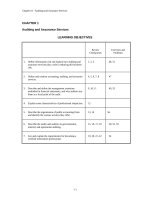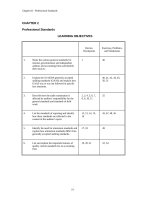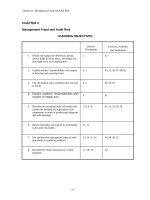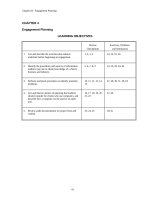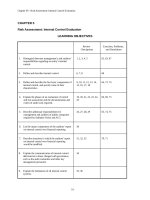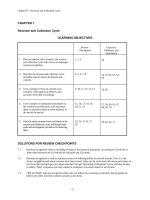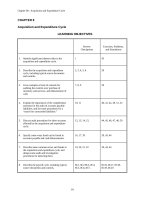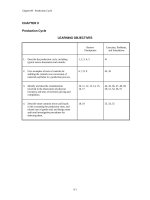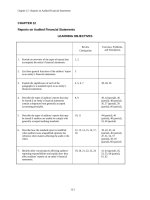Solution manual cost and managerial accounting by barfield 3rd financial management
Bạn đang xem bản rút gọn của tài liệu. Xem và tải ngay bản đầy đủ của tài liệu tại đây (60.73 KB, 30 trang )
Chapter 15
Financial Management
Questions
1.
The cost control system is an integral part of the cost
management system. The cost control system provides
information for planning purposes and, subsequently, for
evaluation of actual performance.
2.
Without first establishing performance targets and benchmarks,
control systems cannot function. The purpose of establishing
control systems is to guide the organization toward its
established objectives. Accordingly, the control cycle must
begin with the establishment of plans that define where the
organization is headed and what its managers want to
accomplish.
3.
Cost control for any specific event is exerted before, during,
and after the event. Cost control is exerted before the event
to determine the expected cost and to provide a plan to
achieve the expected cost. During an event, control is
exerted to maintain the cost being incurred at the planned
level. After an event, actual performance is compared to
planned performance and explanations of differences are
developed. By understanding why differences exist, managers
can take actions to minimize future differences between the
actual and planned amounts.
145
146
4.
Chapter 15
Financial Management
Factors potentially causing a cost to change include:
(1) changes in activity level;
(2) change in inflation/deflation;
(3) technology changes;
(4) changes in supply and demand;
(5) quantity of competition;
(6) seasonality and other timing phenomena; and
(7) quantity purchased.
Factors 1 and 5-7 are most subject to cost containment.
The difference in controllability is the extent to which the
factor can be influenced by actions of managers. The factors
that are external to the firm are less subject to control than
(e.g., inflation) internal factors (e.g., activity levels).
5.
General price-level changes are reflected economy-wide.
Prices for all goods and services rise at comparable rates.
Specific price-level changes affect only certain industries,
parts or commodities. General and specific price-level
changes are similar in that their effects are similar-prices
or goods and services rise or fall. They differ in that
general price-level changes are caused by macroeconomic
factors such as the supply of money and the rate of inflation.
Specific price-level changes are caused by specific events
such as the Gulf War, weather, or interruption of the
distribution channel.
6.
By cooperating with members of the supply chain, an
organization creates an opportunity for interorganizational
cost management. In sharing information, suppliers can inform
customers about alternatives that would lower the suppliers’
costs and result in reduced prices to the customers.
Additionally, opportunities for outsourcing activities may be
identified for circumstances in which a supplier firm can
provide a service, commodity, or part at a lower cost than the
customer firm.
7.
This statement is not true. Single-source contracts have
the potential to provide two advantages. The first is volumebased purchasing. High-volume purchasing should command a
lower price. Secondly, single-source purchasing offers
greater opportunities for sharing information between supplier
and customer firms to identify ways to jointly reduce costs
and increase profits. However, only if these two
opportunities are actively pursued will cost benefits be
realized. Further, for commodity goods, single-source
purchasing may offer no advantages because the purchase price
is determined strictly by the market.
8.
Chapter 15
147
Financial Management
Cost avoidance means not spending money for unneeded goods or
services; cost reduction refers to using fewer goods or
services to lower expenditures. The former often means finding
alternatives to avoid using the goods or services whereas the
latter usually means using fewer of the same goods or
services.
9.
Temporaries are used to avoid paying extra full-time personnel
for work that is only needed to meet peak loads. Temporary
workers can be “fired” after the need for their contribution
abates. Use of temporaries also avoids paying all of the
fringe benefit costs associated with full-time employees and
can provide the special expertise that is not available from
full-time employees.
However, use of temporaries creates new problems. For
example, temporaries have no loyalty to the company because
they know they have only temporary positions. Further,
temporary employees may demand much higher pay than permanent
workers to compensate for the absence of fringe benefits and
the security of a permanent position. Use of temporary
workers may also cause problems of job or task continuity
because of worker turnover.
10.
Total fixed costs can be dichotomized into two groups,
committed and discretionary. The committed fixed costs are
ones that are less susceptible to cost control efforts, at
least during the short run. These costs consist of costs
associated with basic plant assets and organizational
infrastructure. Discretionary fixed costs are more
susceptible to short-run cost control efforts. Discretionary
fixed costs are incurred as a result of managerial judgment.
Examples of such costs are research and development and
advertising.
Costs considered as committed by one firm may be
considered discretionary by other firms. For example, a firm
that competes on the basis of products containing the latest
functionality and technology would consider research and
development to be committed. A firm that competes on the
basis of price might consider research and development to be
discretionary.
11.
No all discretionary costs are not fixed; some can be
variable. For example, a firm may decide to spend one cent of
each sales dollar on advertising. This is an example of a
discretionary variable cost.
148
12.
Chapter 15
Financial Management
Heavy investment in automated technology affects a firm’s cost
structure. The main effect is an increase in committed fixed
costs. A negative consequence is that, as the proportion of
committed fixed costs to total costs rises, fewer and fewer
costs are avoidable as sales fall. The result can be
substantial operating losses in economic downturns. Such
losses can threaten the ability of the firm to remain solvent
and survive. Even so, as an industry becomes more and more
competitive, firms will make increased investment in automated
technology to control operating costs and quality. The
challenge for such an industry then becomes finding ways to
maintain sales volume during economic slumps.
13.
Issues to be considered when setting discretionary cost
appropriations are:
·
What discretionary activities should be funded to help
management effectively and efficiently achieve its
objectives?
·
Can management satisfactorily determine if the activities
are the cause of alleged benefits?
·
Are prospects for profits adequate to support the planned
discretionary activities?
14.
Committed fixed costs are incurred based on long-term
considerations and are simply not controllable in the short
term. Discretionary fixed costs can be increased or decreased
to manage income and cash flow. The budgeted amounts for
discretionary fixed costs are therefore much more likely to be
determined by short-run objectives. Even so, some
discretionary fixed costs (e.g., maintenance, research and
development) are incurred for long-term benefit and will be
less correlated with short-term objectives such as profit and
cash flow.
15.
Many types of discretionary costs do not have outputs for
which there is a precisely explainable and predictable
technical relationship with inputs. When an output measure is
devised, it is normally available only in nonmonetary,
surrogate terms.
For some discretionary costs such as research and
development, output may result, if at all, only after making
inputs for a period of indefinite duration. Thus, even when
outputs occur, it is difficult to relate them to a particular
period's input.
16.
A surrogate measure of output is an indirect or substitute
measure. The results of discretionary cost activities are
often not susceptible to direct financial measurement so
nonmonetary surrogate measures are used.
17.
Chapter 15
149
Financial Management
Efficiency is a measure of the degree to which the actual
yield ratio (actual output ÷ actual input) conforms to the
desired yield ratio (planned output ÷ planned input).
Effectiveness is a measure of the degree to which a goal or
objective is achieved.
Measuring the efficiency of a discretionary cost requires
both a measure of input and a measure of output. Efficiency
further requires a predictable cause-and-effect relationship
between input and output. Input costs are readily measured.
However, as explained in the answer to Question 15, outputs
are not normally readily available. When they are readily
available or when surrogates can be identified, there is still
often a lack of confidence about the strength of the causeand-effect relationship between input and output for most
discretionary costs.
To measure effectiveness of a discretionary activity, an
output measure, either monetary or nonmonetary, must be
available or devised. Sometimes a surrogate measure for output
of an activity can be agreed on. Effectiveness of a
discretionary cost can then be measured by comparing actual
output to planned output (i.e., actual output ÷ planned
output).
18.
Management performance is evaluated by how efficiently and
effectively the company's goals are achieved. Efficiency
measures the relationship between inputs and outputs.
Effectiveness compares outputs to objectives. Objectives are
short-run targets set to achieve long-run goals. Thus, there
is a linkage starting with inputs and ending with goal
achievement to measure the efficiency and effectiveness with
which managers have performed.
19.
Engineered costs, unlike most discretionary costs, bear a
constant and observable relationship to changes in an
activity. However, some discretionary costs can, under the
appropriate conditions, be treated as if they were engineered
costs for the purpose of control. If output measures can be
identified, then yield ratios (output ÷ input) can be devised
to evaluate control of discretionary costs.
20.
Quality control inspection cost is sometimes susceptible to
treatment as an engineered cost. Other examples of activities
that could be engineered include maintenance tasks, machine
setups, and employee training activities.
150
21.
Chapter 15
Financial Management
Variance analysis can be used to evaluate cost control of
engineered costs in a manner similar to that used in standard
costing. For a given engineered cost, the difference between
the flexible budget amount and actual cost is determined.
This amount is the total variance. This total amount can be
divided into a price and efficiency variance. The price
variance captures the amount of the total variance due to
paying more or less than the budgeted amount per unit of
input. The efficiency variance is the amount of the total
variance that is due to using a total input quantity that is
above or below the budgeted input quantity.
22.
Budget-to-actual comparisons are necessary to control the
level of spending on discretionary fixed costs. Only by such
comparisons will total expenditures on such costs be
controlled. However, budget-to-actual comparisons should not
be the only control measure. Additional analysis should
determine whether the budgeted activities were at the expected
level.
23.
A planning budget is fixed at a given level of output volume.
Often, the actual output level will not conform to this
planned level of output. Accordingly, costs and revenues will
differ from the budgeted level because of volume differences.
In evaluating the performance of managers who have no
control over volume, it is desirable to have a budget that is
based on the actual volume level. Accordingly, a flexible
budget is used to evaluate the success of such managers and it
is compiled at the actual level of activity.
24.
Activity-based budgeting is an improvement over traditional
budgeting in that costs are organized by activities that are
necessary for the organization to achieve its objectives.
This approach makes more transparent to managers what
consequences would result if particular costs were cut. It
also serves to highlight the cost of activities that aren’t
necessary to achieving organizational objectives.
25.
Firms hold cash balances to liquidate planned transactions as
they occur, to cover cash consequences of unexpected events,
and for speculative purposes.
Some firms must carry relatively larger cash balances
than other firms because either the cash required to maintain
the liquidity of the operating cycle is less predictable, or
the ability to obtain cash from financing sources is more
constrained.
26.
Chapter 15
151
Financial Management
Program budgeting is typically used in governmental agencies
or for special initiatives in private firms. The process of
program budgeting begins with a specification of the
objectives to be achieved from the initiative or “program.”
Then, alternatives to achieving the objectives are identified.
Finally, costs are budgeted for the activities that are
selected to generate the desired objectives. The process of a
zero-base budget begins with no assumptions based on prior
years’ data. Each activity and dollar must be justified based
on their contribution to organizational goals. A traditional
budget has as its starting point a sales projection and cost
data from prior periods. Past relationships between costs and
activities are used as the basis to extrapolate and budget the
level of future costs.
27.
Program budgeting requires the use of detailed surrogate
measures which necessitates answering several questions:
• What results should be measured?
• What results are significant enough to develop output
measures?
• Can cause be established between programs and results?
and,
• Does the program affect the target population?
Determining answers to these questions can be very
difficult. Because many “programs” involve expenditures on
discretionary activities, it is difficult to map inputs into
outputs. Although the costs of the inputs can be reasonably
determined, the value of the outputs may be difficult to
establish and the extent to which objectives have been
achieved can be difficult to measure.
28.
Among the problems associated with zero-base budgeting are
• Its cost. Zero-base budgeting is much more expensive than
traditional budgeting because of the added time involved.
• The requirement that all activities necessary to the
achievement of an objective be specified. This requirement
implies that the benefits of discretionary activities can
be measured. For some activities, measurement of outputs
can be very difficult.
• That it requires a total commitment from all personnel. An
organization must have the right culture to obtain this
commitment.
Chapter 15
Financial Management
152
Exercises
29.
a.
b.
c.
d.
e.
f.
g.
h.
i.
6
2
5
1
9
8
3
7
4
30.
a.
Cost reduction-because quantity of work fluctuates, parttime employees provide services for peak caseload times
without full-time cost.
b.
Annual salary full-time clerical staff ($28,500 × 1.20) =
$34,200; if 1,600 hours or less, part-time salary = $20X;
if over 1,600 hours, part-time salary = $20X + $2,000
For 1,600 or fewer hours, point of indifference:
$20X = $34,200
X = $34,200 ÷ 20
X = 1,710 hours
For more than 1,600 hours:
$20X + $2,000 = $34,200
$20X = $32,200
X = 1,610 hours
Thus, the point of indifference occurs at 1,610 hours,
the level that triggers the payment of the bonus.
31.
a.
b.
c.
d.
e.
f.
Cost understanding
Cost reduction
Cost avoidance for the cost of call-forwarding; the
increase in costs for staff shows a recognition of client
need and services to be provided
Cost avoidance
Cost reduction
Cost avoidance of what would have been an increase in
costs with the installation of the new telephones; also
shows cost understanding since she knew why the cost
would increase
32.
a.
Chapter 15
153
Financial Management
Classification
Cost
C
Annual audit fees
C
Annual
report preparation and
printing
C
Building flood insurance
D
Charitable contributions
D
Corporate advertising
D
Employee continuing education
C
Office equipment depreciation
C
Interest on bonds payable
D
Internal audit salaries
D
Marketing research
D
Preventive maintenance
C
Property taxes
D
Quality control inspection
D
Research and development salaries
D
Research and development supplies
(the amount is discretionary only if
R&D is to be conducted internally)
D
Secretarial pool salaries
b.
Building flood insurance, charitable contributions,
corporate advertising, executive training, employee
continuing education, internal audit salaries, marketing
research, preventive maintenance, quality control
inspection, research and development salaries, research
and development supplies, secretarial pool salaries.
Cost
Charitable
contrib.
Chapter 15
Financial Management
Surrogate Output Measure
Improvement in social
welfare
Advertising
Increase in sales
Uncertainty about
cause & effect
Employee
education
Increase in productivity,
quality
Difficult to
capture all costs
and benefits
Internal
audit
# of internal controls
improved
No single measure
will capture all
benefits of
internal auditing
Market
research
# of new products identified Doesn’t capture
the value of the
product ideas
154
c.
Objections
Very difficult to
measure
Prev. maint. Reduction in number of
breakdowns
Age of machines
plays a bigger
role in # of
breakdowns than
maintenance does
Q. control
Reduction in # of defective items returned
by customers
Other factors
such as careless
handling by those
moving products
may cause defects
R & D
salaries
Number of discoveries,
inventions, improvements,
etc.
These outputs are
so heterogeneous
as to not be additive
R & D
supplies
Expenditures per dollar of
R&D salary
Doesn’t capture
benefits of
expenditure
Secr. pool
Number of documents
prepared
Does not necessarily measure
quality of work
33.
a.
b.
c.
d.
e.
f.
g.
i.
j.
34.
a.
b.
c.
d.
e.
f.
35.
a.
b.
c.
d.
e.
f.
g.
36.
Chapter 15
155
Financial Management
C Committed costs are often associated with capital
investment.
D Amounts can be set by managerial judgment.
C Committed costs often can not be reduced in the short
run by managers.
D Hence, the term “discretionary”
C These are examples of costs that are associated with
capital investment.
D Because the cause/effect association is often not well
understood for discretionary costs.
D Only discretionary costs can be reduced in the short
run without impairing a firm’s long-term viability.
h.
C Committed costs are associated with capacity and
capital investment.
D Because the yield on discretionary costs is not
precisely known.
D Discretionary activities tend to be service activities
rather than costs associated with the basic.
infrastructure
Extent to which ABC has been implemented in the firm;
dollars of cost savings generated by ABC prescriptions
Number of patient hours of treatment on the machine
Change in employee retention rate, absenteeism rate
Improvement in employee satisfaction, measures capturing
improvement in flow of people
Customers generated from Yellow Page advertising
Labor time savings, reduction in collection cycle,
Dollar volume of wagers
Direct labor cost per drink served
Average number of nights per customer served
Percentage of guests served from out-of-state
Total number of convention customers served
Develop a customer evaluation form to measure quality
based on a five-point scale; use average rating for
measure
Percent of revenue from slot machines relative to total
revenues generated
a.
Goal
300 new students
Actual achievement 330 new students
Goal exceeded by
30 new students; consequently, the
department was very effective in meeting its goal.
b.
Yield goal: ($400,000 ÷ 300) = 1 student for each $1,333
expended.
Actual efficiency ($468,600 ÷ 330) = 1 student for each
$1,420 expended. Accordingly, the department was very
operationally inefficient in pursuing its objectives.
Chapter 15
Financial Management
Total variance = $2,280 - ($1,680 + $288) = $312 U
Rate variance = $2,280 - [(120 × $16) + (15 × $24)]
=
$0
Efficiency variance = $2,280 - $1968 = $312 U
156
37.
38.
a.
Rate variance = $20,928 - (1,030 × $18) = $2,388 U
Efficiency variance =$18,540-((12,560÷ 12) × $18)= $300 F
Total variance = $2,388 U + $300 F = $2,088 U
b.
39.
170 hours × 12 inspections per hour = 2,040 inspections
per worker
Cost for full-time workers = $5,000 × 4 =
$20,000
Part-time work ((1,030 - (170 × 4)) × $18=
6,300
Total cost of this arrangement
$26,300
Total expected cost of existing arrangement:
1,030 × $18
18,540
Disadvantage of full-time arrangement
$ 7,760
Actual
Actual Vol. at Std. Price
Budget
1,800 × $45
1,800 × $40
1,875 × $40
$81,000
$72,000
$75,000
|
| |
|
|
$9,000 F
| |
$3,000 U
|
Price Variance
Volume Variance
|
$6,000 F
Total Revenue Variance
|
Even though the volume of sales was 75 cords below expectation
(creating an unfavorable $3,000 volume variance), the average
price of the 1,800 cords actually sold was $5 above the
standard or expected price. This created a $9,000 favorable
price variance. The combination of the $3,000 unfavorable
volume variance and the $9,000 favorable price variance
results in a $6,000 favorable total variance, and not a $4,200
total variance as stated by the company president.
40.
a.
Expected quantity (400 × 115%)
Expected selling price ($60 × 0.90)
Expected revenue
b.
AV × AP
AV × SP
470 × $54
$25,380
|
|
|
|
460
× $54
$24,840
Budgeted Volume × SP
460 × $54
$24,440
$24,840
|
|
|
$940 U
$540 F
|
Price Variance
Volume Variance
|
|
|
$400 U
|
Total Revenue Variance
Chapter 15
Financial Management
41.
a.
b.
c.
d.
e.
f.
g.
h.
i.
j.
42.
a.
Z
B
P
Z
T
B
Z
B
T
T
Inflation index = 4.44 ÷ 3.93 = 1.13
Inflation
2000
Cost Category
1995 Cost
Index
Expected
Wage and fringes $160,000
1.13
$180,800
Supplies
50,000
1.13
56,500
Depreciation
36,000
1.13
40,680
Utilities
4,800
1.13
5,424
Totals
$283,404
b.
157
2000
Actual
$125,000
85,000
58,000
6,600
$274,600
The pattern of change in costs reflects both effects of
inflation and effects of changes made by management. The
large decline in wage and fringe benefits cost is due
mostly to the decline in headcount. The number of
employees was reduced from eight to five. Although the
individual effects of inflation and technology changes
cannot be disentangled using the information given, the
increase in expenditures for supplies, depreciation and
utilities has dramatically exceeded the rate of
inflation. It is likely that the major differences
between figures in the 2000 expected column and the 2000
actual column are due to the increased use of technology.
Chapter 15
Financial Management
Variable cost analysis:
Variance = actual cost - flexible budget
= $450,000 - ($400 × 1,050) = $30,000 U
158
43.
Fixed cost analysis:
Actual
Budgeted fixed cost
Applied
1,000 × $200
1,050 × $200
$220,000
$200,000
$210,000
|
| |
|
|
$20,000 U
| |
$10,000 F
|
Spending Variance
Volume Variance
|
|
|
Total Fixed Cost Variance = $10,000 U
|
This method of evaluation would encourage the personnel
workers to hire lower quality workers. Low-quality workers
would generate more turnover than high-quality workers, thus
the volume of business rises; and hiring low-quality workers
requires the Personnel office to incur lower search costs than
would be incurred to hire only high-quality workers.
44.
No solution provided.
45.
a.
In his humorous communication, Mr. Stanley Bing’s
strategy is to raise the level of awareness and cost
consciousness of employees regarding cost understanding
and cost avoidance in the travel and entertainment
category. His remarks display his keen insight and
experience concerning how some employees may take
liberties with company funds.
b.
Mr. Bing was subtly advising employees that the prudence
and reasonableness of their use of company funds in the
travel and entertainment category was about to be
monitored and scrutinized much more carefully than in the
past. The use (or abuse) of these funds had apparently
become more significant recently and greater attention to
their management and control had become necessary. The
clever, lighthearted approach reflects Mr. Bing’s desire
to enlist cooperation without offending.
46.
a.
b.
47.
Chapter 15
159
Financial Management
The proposed maintenance work order system would provide
written documentation for all man hours and materials
used in the maintenance department. This system would
improve cost control by giving operating management (user
departments) the opportunity to review specific
maintenance charges for time and materials on each
maintenance job charged to their department. The
individual job cost records will provide the basis for
feedback to the maintenance department on the quality and
efficiency of work performed.
By providing an estimate for each job prior to
starting the job, the user department will have an
opportunity to cancel unneeded work or work that appears
to be too expensive. The maintenance department will be
able to compare the estimates with estimates on similar
jobs and with the actual costs once the job is completed
in order to evaluate personnel performance. In addition,
the estimating should improve scheduling of priority jobs
and improve cost control as the estimating procedure is
refined.
The maintenance work order system will provide a
basis for improved allocation of costs to user
departments. If the work order system is effective and a
buyer/seller relationship is developed between the user
department and the maintenance department, the user
department will insist on an efficient preventive
maintenance program in order to minimize breakdown
maintenance, spoilage, and lost production time.
The documentation provided by the work order system
should provide maintenance department management with
statistics to support its request for additional people.
If the maintenance department can develop a meaningful
cost/benefit relationship showing a payback on additional
personnel through reduced overtime, less downtime waiting
for repairs, improved preventive maintenance, etc.,
rational management would authorize the addition of the
required manpower.
(CMA adapted)
An approach should be used that allows for planned reductions
in costs without adversely affecting the quality of products
or services delivered to customers. By delineating all
activities and associated costs necessary to deliver high
quality products and services to the clients of the Medical
Products Division, managers can identify opportunities for
cost reductions. The objective would be to eliminate
activities that are not instrumental to serving customers and
find more efficient ways to execute required functions.
160
48.
Chapter 15
Financial Management
The firm may have too much cash invested in working capital.
The two accounts consuming the most cash are accounts
receivable and work in process inventory. Accounts receivable
can be reduced by finding ways to speed up collections. For
example, arrangements can be made to electronically collect
accounts from customers. Terms of sale can be tightened and
stricter policies for granting credit can be imposed. For
work in process inventory, ways can be found to reduce the
inventory level. For instance, by speeding up production
processes, less time will be consumed from the start to
completion of production. Methods such as just-in-time
inventory management would be useful.
Also, the company’s payables are very small relative to
current assets. Current payables can be used as free
financing for current assets. To illustrate, the company
could negotiate for credit terms from its suppliers. This
credit would be a source of financing for inventory and
accounts receivable and would free up cash the company
currently has invested in these accounts.
Problems
49. a.
b.
c.
d.
e.
f.
g.
h.
i.
j.
k.
l.
50.
a.
CU
CU
CA
CU
CU
CA or CR
CA
CR
CU
CA
CC
CA
(From employer perspective)
Advantages
Disadvantages
Less expensive
Possibly lower quality
Flexibility
Not avail. as much out of class
b.
Lower cost
Less loyalty to the firm
c.
Greater availability
of personnel
Less expensive
Possibly less competence
Less continuity
d.
Less expensive
Flexibility
Possibly poor quality writing
Less control over writers
51.
Chapter 15
161
Financial Management
Possibly lower quality work
Possibly less reliable
Possibly less responsive
Greater possibility of theft
e.
Availability
f.
Less expensive
Availability
Less training
Possibly less loyalty
Possibly poorer customer relat.
g.
Less expensive
Possibly less reliable
Possibly less control
Possibly lower quality of work
h.
Less expensive
Possibly lower quality of work
Possibly less reliable
Possibly less control
i.
More alert employees
Less expensive
Lower pension & benefits
costs
Possibly lower quality of work
Possibly less competent workers
Lack of company loyalty
j.
Provides more flexible
capacity
Lower cost
Availability of more
workers
Inconsistent work
Reduced ability to control
quality
k.
Availability
Better quality of life
for Mom & Pop
Less expensive
Potential theft
Potential damage to relations
with customers
a.
7,800 × .98 = 7,644 flawless gaskets per kwh.
b.
Achieved efficiency per kWh = (1,390,000 – 17,900) ÷ 175
= 7,840.6 gaskets per kwh
which exceeds the standard
by 196.6 flawless gaskets
per kWh.
c.
Achieved effectiveness = 17,900 ÷ 1,390,000 = 1.29%
flaws, versus the expected 2.0% rate of flaws. Thus, the
machine is more effective in producing flawless output
than claimed.
162
d.
Chapter 15
Financial Management
kWh at standard efficiency:
[(1,390,000 – 17,900) ÷ 7,644] = 179.5 kWh.
Std. kWh
Act kWh
kWh saved
Cost per kWh
Cost savings
52.
179.50
175.00
4.50
× $3.20
$14.40
e.
An automobile manufacturer would want zero defects in the
gaskets it purchases and would expect the vendor to have
sufficient quality control measures to virtually ensure
this.
a.
EDP Department Costs
Variable
Fixed
Total
Actual
$ 87,750
402,000
$489,750
Appropriation
$100,000
400,000
$500,000
Unexpended
Appropriation
$12,250
(2,000)
$10,250
The EDP manager stayed within his $500,000 total
appropriation even though he overspent on the fixed
portion of it. Top management would not view this as a
problem unless the appropriation had been granted
separately for the variable and fixed components rather
than on a total basis.
b.
Actual output = 1950 = 0.975
Planned output
2000
The department was reasonably effective if the above
ratio is a viable surrogate for effectiveness. However,
it is somewhat problematic in this case in that
management has been looking askance at the rapid
expansion of EDP department services. Also, this
calculation does not measure the quality of the output.
c.
Actual output
Actual input
vs. Planned output
Planned input
Variable expenses efficiency:
1950 hours= 1 hour per $45 vs. 2000 hours= 1 hour per $50
$87,750
$100,000
(actual efficiency exceeds expectations)
Fixed expenses efficiency:
1950 hours= 1 hr. per $206 vs. 2000 hours= 1 hr. per $200
$402,000
$400,000
(actual efficiency is slightly less)
Chapter 15
Financial Management
d.
163
(1)
Actual
Actual Hrs. × Std Rate
Hrs.Earned × Std. Rate
1,950 × $50
1,950 × $50
$87,750
$97,500
$97,500
|
| |
|
|
$9,750 F
| |
$0
|
Spending Variance
Efficiency Variance (note)
|
|
|
$9,750 F
|
Total Variable EDP Cost Variance
Note: Since input hours of service are all assumed to be
good hours of output in this case, there is no efficiency
variance. If a separate measure of output can be devised,
an efficiency variance can be calculated.
(2)
Actual
Hrs. Earned × Std. Rate
1,950 × $200
$402,000
$400,000
$390,000
|
| |
|
|
$2,000 U
| |
$10,000 U
|
Spending Variance
Volume Variance
|
|
|
$12,000 U
|
Total Fixed EDP Cost Variance
e.
Budget
To do this, normal or anticipated hours of utilization
must be specified. In the case at hand, a first
approximation can be found by dividing the current year
budgeted fixed costs by the number of anticipated
(budgeted) hours ($400,000 ÷ 2,000 = $200 per hour) and
the budgeted variable costs by the budgeted service hours
($100,000 ÷ 2,000 = $50 per hour). Combining the fixed
and variable rate ($200 plus $50), a total of $250 per
hour of computer time is indicated.
It seems reasonable to believe that charging almost
$250 per hour for computer time where there was no charge
previously would cause a reduction in demand. A reduction
in demand would cause the fixed portion of EDP department
costs to be averaged over fewer hours, resulting in an
even higher charge per hour. For instance, if demand
could be expected to drop by 20 percent to 1,600 hours,
then the fixed rate per hour would rise to $250 ($400,000
÷ 1,600) and the total charging rate would rise to $300
per hour.
164
53.
54.
a.
Chapter 15
Financial Management
This finding represents both efficiency and
effectiveness. It is primarily for cost avoidance. Use
of simple, inexpensive antibiotics is found to be better
treatment (more effective) and less expensive (more
efficient). It is cost avoidance because it calls for
using a lower-cost alternative.
b.
This finding represents efficiency. It is primarily cost
avoidance. Watchful waiting does the job better than
using expensive MRIs and is a lower cost substitute.
c.
This finding represents effectiveness. Medical
professionals find reduced likelihood of dying from heart
attacks by prescribing aspirin and/or beta blockers.
d.
This finding represents effectiveness. Medical
professionals find that inhaled steroid medications can
prevent disability and complications among asthmatic
patients.
e.
This finding represents efficiency. It is primarily cost
avoidance. Patients trained to avoid asthma triggers,
measure their own lung function, follow a consistent
treatment plan, and make adjustments in their own
medications is a much lower cost substitute than extended
hospital stays and emergency room visits.
a.
A flexible budget allows management to directly compare
the actual cost of operations with budgeted costs for the
activity achieved. It assists management in evaluating
the effects of varying levels of activity on costs,
profits, and cash position, thus aiding in the choice of
the level of operation for planning purposes.
The flexible budgets presented are based on three
different activity measures, none of which coincides with
the actual level of performance for November. The budget
must be restated to a level of activity that matches the
actual results. The fixed and variable components of the
mixed costs must be segregated and a budgeted cost
calculated for the level of activity attained.
b.
Chapter 15
165
Financial Management
Sales salaries are the only cost that varies perfectly
with number of salespersons ($90,000 ÷ 100 = $900). The
following vary with sales orders:
Sales commissions $300 per sales order
Sales travel
100 per sales order ($50,000 assumed
fixed)
Sales off. expense 30 per sales order ($400,000 assumed
fixed)
Shipping expense
100 per sales order ($500,000 assumed
fixed)
Total Var. cost
$530 per sales order
c.
Johnson Lighting, Inc.
Selling Expense Report - November
Monthly Expenses
Adver. & promo.
Admin. salaries
Sales salaries 1
Sales commissions2
Salesperson travel3
Sales off. expense4
Shipping expense5
Budget
$1,500,000
75,000
81,000
447,000
199,000
448,000
660,000
$3,410,000
Actual
$1,450,000
80,000
92,000
460,000
185,000
500,000
640,000
$3,407,000
Variance
$50,000
5,000
11,000
13,000
14,000
52,000
20,000
$ 3,000
F
U
U
U
F
U
F
U
($90,000/100) × 90 = $81,000
($450,000÷$15,000,000) × $14,900,000 = $218,800
3Change in cost: $225,000 - $200,000 = $25,000
Change in sales dollars: $17,500,000-$15,000,000 = $2,500,000
Variable cost per dollar of sales = change in cost divided
by change in activity level: $25,000÷$2,500,000 = $.01 per
dollar of sales
Fixed cost at $15,000,000: $200,000 - ($15,000,000 × .01)
= $50,000
Total travel budget: $50,000 fixed + (14,900,000 × .01)
=$199,000 (variable = $149,000)
4Change in cost: $452,500 - $445,000 = $7,500
Change in number of orders: 1,750 - 1,500 = 250
Variable cost per order: $7,500 ÷ 250 = $30
Fixed cost: $445,000 - (1,500 × $30) = $400,000
Total office expense budget: $400,000 + (1,600 × $30) =
$448,000
5Change in cost: $675,000 - $650,000 = $25,000
Change in number of units: 17,500 - 15,000 = 2,500
Variable cost per unit: $25,000 ÷ 2,500 = $10.00
Fixed cost: $650,000 - (15,000 × $10.00) = $500,000
Total shipping expense budget: $500,000 + (16,000 × $10.00) =
$660,000
1
2
166
d.
Chapter 15
Financial Management
Sales salaries ÷ number of salespersons = $92,000 ÷ 90 =
$1,022 fixed cost (rounded)
Note: to estimate the actual variable cost portion of the
mixed costs, we assume the fixed portion of the mixed
cost was equal to the budgeted amount.
Actual variable cost per sales order: Commissions ÷
number of orders = $460,000 ÷ 1,600 = $287.50
Variable travel ÷ number of orders = ($185,000 - $50,000)
÷ 1,600 = $84.38 (rounded)
Variable office expense ÷ number of orders = ($500,000 $400,000) ÷ 1,600 = $62.50
Variable shipping expense ÷ number of orders = ($640,000
- $500,000) ÷ 1,600 = $87.50
55.
e.
To comment on effectiveness would require knowledge of a
target sales figure. If such a target had been less than
or equal to $14,900,000, the salespersons could have been
considered effective. Otherwise, a degree of
effectiveness of less than 100% must be assigned.
The manager of sales expenses may be considered to
be slightly more than 100% efficient as evidenced by the
$3,000 favorable variance presented in part c.
(CMA adapted)
a.
Budgetary slack is a planned difference between budgeted
revenue and expected revenue and/or budgeted expenditures
and expected expenditures. Budgetary slack describes the
tendency of managers to underestimate revenues and
overestimate expenditures during the budgetary process in
order to build in allowances for unexpected declines in
revenue and/or unforeseen expenses. Budgetary slack
occurs because of conflicts between a manager's personal
interests and the interests of the organization. These
conflicts include pressure from management to achieve
budgets and the desire on the manager's part to look good
in the eyes of upper management.
•
•
•
b.
(1) From the point of view of the business
unit manager, budgetary slack provides
Flexibility under unexpected circumstances.
The opportunity to show consistent performance
despite variations in departmental resources and
workloads.
A blending of personal and organizational goals.
Chapter 15
167
Financial Management
(2) From the perspective of corporate
management, the use of budgetary slack increases the
probability that budgets will be achieved. This
increased probability facilitates the overall
corporate budgeting process. Corporate management
may also allow budgetary slack as a form of reward
to managers for previous good performance.
From the point of view of corporate
management, the use of budgetary slack increases the
likelihood of inefficient allocation of scarce
corporate resources, decreases the effectiveness of
the corporate planning process, and decreases the
ability to identify potential weaknesses or trouble
spots in the budgetary process and, thus, limits
corrective actions.
c.
(1) Zero-base budgeting is a planning and
budgeting technique that evaluates all proposed
operating and administrative expenditures as though
they were being initiated for the first time. Each
manager must evaluate each expenditure, investigate
alternative means of conducting each activity,
evaluate alternative budget amounts for various
levels of service, justify each expenditure, and
finally, rank expenditures in order of importance.
(2) Winston Labs could benefit from zero-base
budgeting as each of the business unit managers
would be required to specifically identify and
justify all proposed expenditures for the upcoming
year. This increased evaluation of expenditures
would make it difficult to include budgetary slack
in the budget for the upcoming year.
(3)
The biggest disadvantage of zero-base budgeting is
the significant amount of time and cost involved in
its implementation. Additionally, the concept of
zero-base budgeting may be difficult for management
to learn and accept. Winston Labs must be sure that
the benefits of zero-base budgeting outweigh the
associated costs.
(CMA adapted)
168
56.
Chapter 15
Financial Management
The memo should provide the following information:
Although the activity-based budget provides excellent
information about the costs of the various activities
necessary to fulfill a particular organizational function,
these budgets do not identify the resources (e.g., salaries,
occupancy costs) that are consumed by each activity. A
resource, or traditional budget, will provide this
information. To prepare a resource budget, it is necessary to
understand the relationship between activities and resources.
To estimate the cost of specific resources, it is
necessary to identify the resources associated with each
activity. Next, the quantity of each resource consumed by
each activity is estimated. Finally, using the cost driver of
each resource, the cost of resources associated with each
activity can be estimated. The end product is a resource
budget similar to traditional financial budgets.
57.
Firms accumulate cash for three reasons: to liquidate planned
transactions, to provide for liquidation of unplanned
transactions and for speculation. Internet companies may have
greater needs than traditional companies in all three areas.
Because many Internet companies have operating cycles
that consume, rather than produce, cash, these companies
must have cash available to cover cycle shortfalls. Second,
Internet companies operate in a less predictable environment
and must maintain cash balances sufficient to cover
contingencies. Also, the Internet environment is very fluid,
and Internet companies must maintain enough cash to exploit
unexpected opportunities (e.g., the opportunity to purchase a
weak competitor). Finally, the Internet companies may have
difficulty acquiring cash from either public or private
sources on reasonable terms if the firms are forced to go to
capital markets under distress circumstances.
Chapter 15
Financial Management
169
Cases
58.
a.
Some considerations for the bookstore include:
• Exercise prudent cost management over discretionary
costs. One of the more significant discretionary costs
is advertising.
• Maximize use of technology. Although book handling is
inherently a labor-intensive exercise, transaction
processing related to sales, purchases, and repurchases
can be highly automated to save labor costs.
• Institute programs to reduce employee turnover.
Because many employees may be students, employee
turnover can be very high. Employee turnover increases
specific costs such as employee training, quality
failure costs, and unemployment taxes.
• Arrange floor space to minimize book handling costs and
to facilitate the flow of students.
• Work closely with professors to ascertain which books
will be used in the upcoming semester and which will
not be used again.
• Develop associations with book wholesalers to market
books that are no longer adopted by the local
university.
• Encourage professors to adopt the same book for
multiple sections of the same class to realize
economies of scale in purchasing and shipping.
• Provide incentives to students to purchase books early
so that the work-load can be spread across more time
and be handled by fewer employees.
• Use temporary rather than permanent employees to handle
busy season work.
• Find innovative ways to manage freight costs. Examine
alternative modes of transportation. By ordering
earlier, slower and less expensive freight delivery
modes can be used.
• Rent temporary warehouse space to handle the bulge in
inventory that accompanies the start and end of school
terms.
